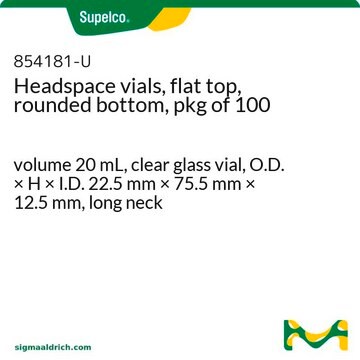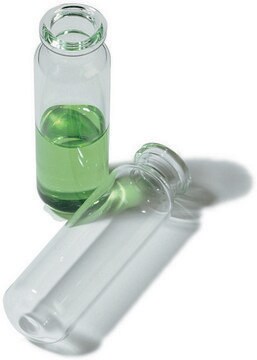SU860097
Headspace vial, screw top, rounded bottom (vial only)
volume 20 mL, clear glass vial, thread for 18, O.D. × H 22.5 mm × 75.5 mm, pkg of 100 ea
Synonym(s):
Screw cap rounded bottom headspace vial
About This Item
Recommended Products
material
clear glass vial
round bottom
feature
closure type screw top vial
packaging
pkg of 100 ea
O.D. × H
22.5 mm × 75.5 mm
volume
20 mL
fitting
thread for 18
compatibility
for use with CTC PAL (Varian, Gerstel, Atas, Shimadzu)
Looking for similar products? Visit Product Comparison Guide
General description
Application
- In the determination of partition coefficient of ethyl acetate in water at 0° C from independent analyses of the total amount of ethyl acetate present in the vial, by automatic equilibrium headspace gas chromatography and vapor phase calibration (VPC).
- It may be used in the analysis of volatile polar residual solvents present in pharmaceutical products, during development and optimisation of headspace SPME method by GC-MS.
- It may also be used in the isotopic analysis of 18O in the leaf water of C3 and C4 grasses, during establishing a grassland signature in veins, as it was found that grasses with different photosynthetic pathway have different interveinal differences.
- It may also find application, in investigating metabolism by Pseudomonas fluorescens of volatile haloaliphatic hydrocarbons like 1,2-dichloroethane and 1,2-dichloropropane, which are some of the major contaminants of underground aquifers.
related product
Choose from one of the most recent versions:
Certificates of Analysis (COA)
Sorry, we don't have COAs for this product available online at this time.
If you need assistance, please contact Customer Support.
Already Own This Product?
Find documentation for the products that you have recently purchased in the Document Library.
Customers Also Viewed
Protocols
High performance, reliability, and reproducibility of HS-SPME in combination with GC/MS for the determination of VOCs in water was proven in an interlaboratory trial. The new ISO 17943 using HS-SPME is an improvement on existing official methods for this determination in terms of sensitivity and selectivity.
Our team of scientists has experience in all areas of research including Life Science, Material Science, Chemical Synthesis, Chromatography, Analytical and many others.
Contact Technical Service








